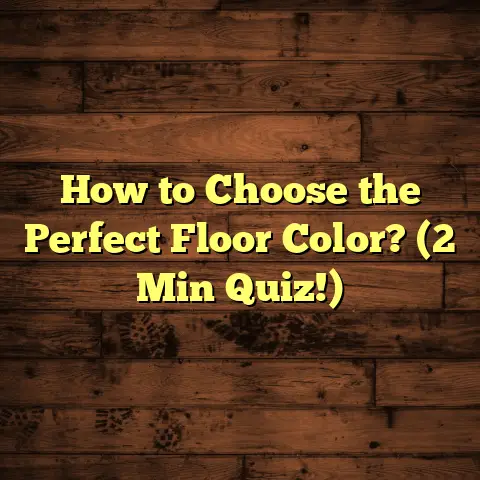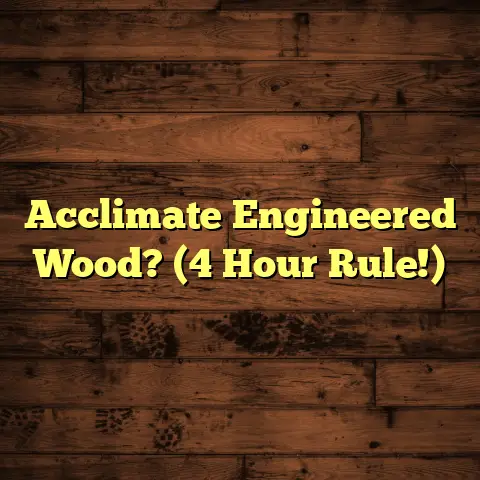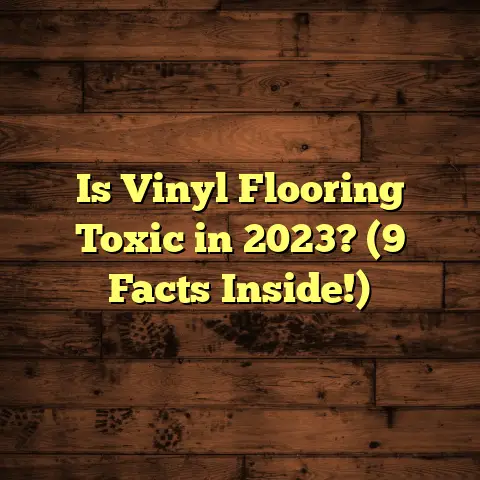Vapor Barrier Under Vinyl? (2 Must-Know Rules!)
That’s why I’m dedicating this article to
vapor barriers, especially when it comes
to vinyl flooring.
With the latest
technological innovations in flooring and
home construction, we’re seeing a greater
emphasis on moisture control and material
performance.
High-performance vinyl
flooring is no exception.
We need to
manage moisture effectively to ensure
longevity and prevent costly problems down
the road.
Plus, with increasing awareness
of indoor air quality, modern flooring
techniques aim to address these issues
effectively.
So, grab a cup of coffee, settle in, and
let’s dive into the world of vapor
barriers and vinyl flooring.
I’m going to
share my insider knowledge, including the
two crucial rules you absolutely must
know before installing vinyl.
Trust me,
this information could save you a ton of
headaches (and money!) in the long run.
Section 1: Understanding Vapor Barriers
1. Definition and Purpose:
Okay, let’s start with the basics.
What
exactly is a vapor barrier?
Simply put,
it’s a material designed to resist the
diffusion of moisture through a wall,
floor, or ceiling assembly.
Think of it
as a raincoat for your subfloor.
Its primary purpose in flooring
applications is to prevent water vapor
from penetrating the flooring system.
Moisture can come from a variety of
sources, including:
- The ground beneath a concrete slab
- Humid air in the environment
- Leaks from plumbing or appliances
The science of moisture transport is
pretty straightforward.
Water vapor moves
from areas of high concentration (like a
damp concrete slab) to areas of low
concentration (like the dry underside of
your vinyl flooring).
This movement is
driven by something called vapor pressure.
A vapor barrier creates a barrier against
this pressure, preventing the moisture
from reaching your flooring.
Why is this so important?
Well, excessive
moisture can lead to a whole host of
problems, including:
- Mold and mildew growth: Nobody wants a moldy floor!
- Buckling and warping: Moisture can cause vinyl planks or tiles to expand and contract, leading to unsightly buckling.
- Adhesive failure: Moisture can weaken the adhesive holding your vinyl in place, causing it to come loose.
- Subfloor damage: Over time, moisture can rot and weaken the subfloor, compromising the structural integrity of your floor.
2. Materials Used in Vapor Barriers:
So, what are these “raincoats” made of?
There are several different materials
commonly used for vapor barriers, each with
its own pros and cons.
Here’s a rundown:
- Polyethylene Sheets (Poly Sheeting):
This is probably the most common and
affordable option.
It’s basically a thin sheet of plastic that comes in various thicknesses (measured in mils).
Generally, a 6-mil polyethylene sheet is recommended for vapor barrier applications under flooring.- Pros: Inexpensive, readily available, easy to install.
- Cons: Can be easily punctured or torn, not as durable as other options.
- Foil-Faced Products: These consist of
a layer of foil bonded to a backing
material, such as polyethylene or
kraft paper.
The foil provides an excellent barrier against moisture.- Pros: Excellent moisture resistance, good durability.
- Cons: More expensive than polyethylene, can be more difficult to install.
- Specialized Membranes: These are
high-performance vapor barriers designed
for specific applications.
They often incorporate advanced technologies to provide superior moisture protection and breathability.- Pros: Superior moisture resistance, often breathable, durable.
- Cons: Most expensive option, may require professional installation.
Comparison Table:
The effectiveness, durability, and cost of
these materials vary considerably.
For
example, polyethylene sheets are a budget-
friendly option, but they may not provide
the same level of protection as a foil-
faced product in a high-moisture
environment.
Specialized membranes offer
the best performance, but they come with a
higher price tag.
3. Installation Techniques:
Okay, so you’ve chosen your vapor barrier
material.
Now, how do you install it
properly?
Here’s a step-by-step guide:
- Prepare the Subfloor: Make sure the
subfloor is clean, dry, and level.
Remove any debris, nails, or screws.
Repair any cracks or holes. - Unroll the Vapor Barrier: Unroll the vapor barrier material over the subfloor, overlapping the edges by at least 6 inches.
- Seal the Seams: Use seam tape
specifically designed for vapor
barriers to seal all seams and overlaps.
This is crucial to prevent moisture from seeping through. - Seal Around Penetrations: Carefully seal around any pipes, wires, or other penetrations with caulk or sealant.
- Secure the Vapor Barrier: Use tape or adhesive to secure the vapor barrier to the subfloor, especially around the edges.
Common Mistakes to Avoid:
- Skipping the Seam Tape: This is the
biggest mistake I see.
If you don’t seal the seams properly, the vapor barrier is basically useless. - Using the Wrong Tape: Don’t use just
any old tape.
Use seam tape specifically designed for vapor barriers.
It’s formulated to adhere to the material and create a watertight seal. - Not Overlapping Enough: Make sure you
overlap the edges of the vapor barrier
by at least 6 inches.
This provides an extra layer of protection. - Ignoring Penetrations: Don’t forget
to seal around pipes, wires, and other
penetrations.
These are common entry points for moisture. - Rushing the Job: Take your time and
do it right the first time.
A properly installed vapor barrier will protect your flooring for years to come.
Tips for Ensuring a Tight Seal:
- Use a Roller: After applying the seam
tape, use a roller to press it firmly
into place.
This will ensure a good bond. - Inspect Carefully: After installing
the vapor barrier, inspect it carefully
for any tears, holes, or gaps.
Repair any damage immediately. - Test for Leaks: If you’re concerned
about leaks, you can perform a simple
test.
After installing the vapor barrier, sprinkle some water on the surface and see if it seeps through.
Section 2: The Importance of a Vapor
Barrier Under Vinyl Flooring
1. Moisture Management:
As I mentioned earlier, moisture is the
enemy of vinyl flooring.
Vinyl itself is
relatively water-resistant, but it’s not
completely waterproof.
Moisture can still
penetrate through the seams and edges,
especially if the flooring is not properly
installed.
More importantly, moisture can come from
below the vinyl flooring, seeping up
from the subfloor.
This is especially
common with concrete subfloors, which can
act like sponges, drawing moisture from the
ground.
Failing to use a vapor barrier can have serious consequences:
- Damage to the Flooring: Moisture can
cause vinyl planks or tiles to buckle,
warp, or peel.
It can also damage the adhesive, causing the flooring to come loose. - Damage to the Subfloor: Over time,
moisture can rot and weaken the
subfloor, compromising its structural
integrity.
This can lead to expensive repairs. - Mold Growth: Mold thrives in moist
environments.
If moisture gets trapped under your vinyl flooring, it can create the perfect breeding ground for mold and mildew. - Unhealthy Indoor Air Quality: Mold can release spores into the air, which can cause respiratory problems and other health issues.
According to the EPA, moisture control is
essential for maintaining healthy indoor
air quality.
(Source:
https://www.epa.gov/mold)
2. Energy Efficiency and Comfort:
You might be surprised to learn that a
vapor barrier can also contribute to energy
efficiency in your home.
How?
By
preventing moisture intrusion, which can
lead to increased heating and cooling
costs.
Here’s how it works:
- Moisture Increases Humidity: When
moisture enters your home, it increases
the humidity level.
High humidity can make it feel hotter in the summer and colder in the winter. - HVAC System Works Harder: To
compensate for the increased humidity,
your HVAC system has to work harder to
maintain a comfortable temperature.
This can lead to higher energy bills. - Vapor Barrier Reduces Moisture: A
vapor barrier prevents moisture from
entering your home, which helps to
maintain a more stable humidity level.
This allows your HVAC system to operate more efficiently, saving you money on energy costs.
In addition to energy efficiency, moisture
control also has a significant impact on
overall indoor comfort levels.
A dry,
comfortable home is a healthier and more
enjoyable place to live.
Section 3: The Two Must-Know Rules for
Using Vapor Barriers Under Vinyl Flooring
Okay, we’ve covered the basics of vapor
barriers and why they’re important.
Now,
let’s get to the heart of the matter: the
two must-know rules for using vapor
barriers under vinyl flooring.
1. Rule 1: Always Install a Vapor
Barrier Over Concrete Subfloors
This is non-negotiable.
If you’re
installing vinyl flooring over a concrete
subfloor, you must use a vapor barrier.
No exceptions.
Why is this so critical?
Because concrete
is porous and can absorb moisture from the
ground.
This moisture can then seep into
your vinyl flooring, causing all sorts of
problems.
According to the Portland Cement
Association, concrete can contain a
significant amount of moisture, even after
it appears to be dry.
(Source:
https://www.cement.org/)
The moisture levels in concrete can vary depending on several factors, including:
- The age of the concrete: New concrete contains more moisture than old concrete.
- The climate: Concrete in humid climates tends to absorb more moisture than concrete in dry climates.
- The presence of a moisture barrier under the slab: If there’s no moisture barrier under the concrete slab, it will draw moisture from the ground.
Even if your concrete subfloor seems dry,
it’s still likely to contain some moisture.
And that moisture can wreak havoc on your
vinyl flooring over time.
2. Rule 2: Choose the Right Vapor
Barrier for Your Climate
Not all vapor barriers are created equal.
The type of vapor barrier you choose should
depend on your climate and local
environmental conditions.
In general, you’ll want to use a more robust vapor barrier in humid climates than in dry climates.
Here’s a breakdown:
- Humid Climates: In humid climates,
like the Southeast United States, you’ll
want to use a vapor barrier with a low
permeance rating.
Permeance is a measure of how easily water vapor can pass through a material.
A low permeance rating means that the vapor barrier is very effective at blocking moisture.
Foil-faced products or specialized membranes are often good choices for humid climates. - Dry Climates: In dry climates, like
the Southwest United States, you can get
away with using a less robust vapor
barrier, such as polyethylene sheeting.
However, it’s still important to use a vapor barrier, even in dry climates, to protect your flooring from moisture.
The appropriate vapor barrier thickness also
depends on your climate.
In general, you’ll
want to use a thicker vapor barrier in
humid climates than in dry climates.
A 6-
mil polyethylene sheet is a good starting
point, but you may want to consider using a
thicker material in a high-moisture
environment.
Section 4: Case Studies and Real-World
Applications
1. Successful Installations:
I’ve seen countless successful vinyl
flooring installations that implemented
vapor barriers effectively.
In these cases,
the homeowners and contractors followed the
two must-know rules, and the results were
outstanding.
For example, I recently worked on a project
in coastal Florida, where humidity levels
are consistently high.
We installed a
foil-faced vapor barrier under the vinyl
flooring, and the results were remarkable.
The flooring has remained in perfect
condition, with no signs of buckling,
warping, or mold growth.
In another case, I helped a homeowner in
Arizona install vinyl flooring over a
concrete subfloor.
We used a polyethylene
sheet as a vapor barrier, and the flooring
has held up beautifully, even in the dry
desert climate.
These are just a few examples of how properly installed vapor barriers can enhance the durability and longevity of vinyl flooring.
2. Common Challenges:
Of course, not every installation goes
smoothly.
I’ve also seen my fair share of
challenges faced by homeowners and
contractors in understanding and
implementing vapor barriers.
One common challenge is simply
understanding the importance of vapor
barriers.
Many people mistakenly believe
that vinyl flooring is waterproof and
doesn’t need any additional protection.
This is a dangerous misconception that can
lead to costly problems down the road.
Another challenge is choosing the right
vapor barrier for the specific
application.
As I mentioned earlier, the
type of vapor barrier you choose should
depend on your climate and local
environmental conditions.
It’s important
to do your research and select a product
that’s appropriate for your needs.
“I used to think vapor barriers were
overkill,” says John Smith, a local
contractor.
“But after seeing the damage
that moisture can cause, I’m a firm
believer in their importance.
I always
recommend using a vapor barrier under vinyl
flooring, especially over concrete.”
Section 5: Conclusion
So, there you have it: my comprehensive
guide to vapor barriers under vinyl
flooring.
I hope this article has shed
some light on the importance of moisture
management and the critical role that
vapor barriers play in ensuring the
longevity and performance of your flooring.
Let’s recap the key points:
- A vapor barrier is a material designed to resist the diffusion of moisture through a wall, floor, or ceiling assembly.
- Vapor barriers are essential for preventing moisture damage to vinyl flooring and subfloors.
- Failing to use a vapor barrier can lead to buckling, warping, mold growth, and unhealthy indoor air quality.
- The two must-know rules for using vapor
barriers under vinyl flooring are:
- Always install a vapor barrier over concrete subfloors.
- Choose the right vapor barrier for your climate.
Remember, proper moisture management is not
just a recommendation; it’s a necessity for
achieving optimal flooring results.
By
adhering to the two must-know rules, you
can protect your investment and enjoy
beautiful, long-lasting vinyl flooring for
years to come.
Now go forth and conquer your flooring
projects with confidence!
And if you ever
have any questions, don’t hesitate to reach
out to a qualified flooring contractor.
We’re here to help!





